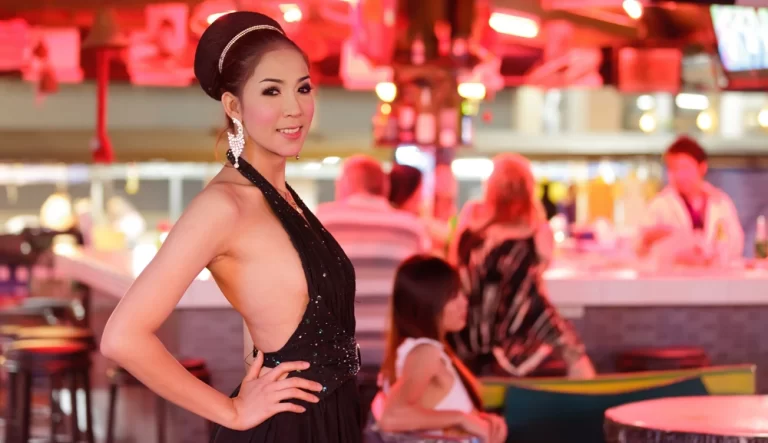In a recent survey, it was found that Thailand, compared to other Asian nations, has the highest population of 'ladyboys' or Kathoey. This intriguing statistic paves the way for an in-depth exploration of the concept and cultural significance of ladyboys.
As part of this discourse, the origins, cultural contexts, and broad-reaching implications of such identities will be examined. The narrative will extend beyond Thailand to include different geographies and local variations like Waria in Indonesia and Hijra in India.
It will also delve into a comparative analysis with Transvestites and investigate how language usage impacts perception. The focus is on fostering a comprehensive understanding of gender identity and expression from a sociocultural perspective - providing insights into platforms such as MyLadyboyCupid that celebrate this diversity.
This exploration aims at promoting empathy towards these often marginalized communities by acknowledging their unique beauty and integral role within society's fabric.
Key Takeaways
| Ladyboys are Asian transgender women, specifically in Thailand, who are widely accepted and celebrated in Thai culture and tradition. |
| Thai Ladyboys have access to most professional domains and can find decent employment outside of sex work. |
| Ladyboys in Thailand are more accepted and tolerated compared to ladyboys in other Asian countries such as the Philippines or Malaysia. |
| Thai Ladyboys have features that are naturally feminine, making their transition easier, and they are often sought after by foreigners for serious relationships. |

Understanding the Terminology: What Exactly is a Ladyboy?
In the cultural landscape of Asia, particularly in Thailand and the Philippines, the term 'ladyboy' has emerged as a unique identifier for transgender women or effeminate gay men. Despite its commonplace usage within these societies, it garners a derogatory connotation in Western dialogue.
The term is an English translation of Kathoey, a Thai word that encapsulates both transgender women and effeminate gay men under its umbrella. In exploring this terminology further, it is crucial to consider social and cultural perspectives, towards creating a comprehensive understanding of gender identity and expression.
Primarily, the term 'ladyboy' finds extensive use in Southeast Asian nations like Thailand. Historically, ladyboys enjoyed a respected societal status in these regions. Indeed, this acceptance contributes to Thailand's significant ladyboy population, outnumbering other Asian countries. Known officially as kathoeys in their native land, these individuals often possess naturally feminine features which facilitate their transition process.
Transgender women in Thailand have access to most professional spheres thanks to societal acceptance; however, many still resort to sex work due to economic factors or personal choice. A significant number find foreigners more open-minded with regard to serious relationships contributing further dimensionality to their social reality.
Understanding the terminology: what exactly is a ladyboy? It's more than just labeling them as third gender or transgender; it involves acknowledging their individuality amidst societal norms and expectations.
Delving into how this term came about provides an interesting segue into examining the origin and cultural context surrounding ladyboys – an essential aspect that shapes perceptions of such identities across different societies worldwide.
💡Read Next: All you ever need to know about Ladyboy definitions and terms
The Origin and Cultural Context of Ladyboys
The cultural phenomenon of 'ladyboys', or Kathoey, as they are known in Thailand, has a deep-rooted history that is intertwined with the country's social and religious fabric. This discussion will explore the origins of this unique gender expression within Thai society, from its prehistoric animistic beliefs to its contemporary acceptance.
Furthermore, an analytical approach will be adopted to examine the evolution of transgender identity in Thailand and how societal attitudes shaped the emergence and development of Kathoeys.
Unveiling the History: Thailand and the Emergence of Kathoey
Exploring the historical context of Thailand, one can observe the emergence and acceptance of Kathoey or 'ladyboys' as an integral part of their society. This development is deeply rooted in the country's unique history and culture, making Thai society a notable exception in terms of its acceptance of transgender people.
- Thai Culture: The Thai ladyboy phenomenon dates back centuries, reflecting the fluid nature of gender in their cultural norms.
- Transgender Acceptance: In contrast to many societies, Thai people have long embraced Kathoey with open arms.
- Historical Perspective: Throughout history, Kathoeys have been visible participants in Thai society.
This rich cultural heritage sets the stage for further exploration into Kathoey's place within contemporary Thai society.
An Exploration of Kathoey Culture in Thailand
The Kathoey community, often colloquially referred to as 'ladyboys,' constitutes a significant segment of Thailand's unique societal fabric. This distinct acceptance and celebration of ladyboys within Thai culture is rooted in its history and traditions, extending beyond tolerance into an embrace of diverse gender identities and expressions.
A comprehensive exploration of this cultural phenomenon illuminates the intricate social dynamics at play, shedding light on how Thailand's unique acceptance fosters a more inclusive environment for the Kathoey community.
The Kathoey Community: Thailand's Unique Acceptance of Ladyboys
Thailand's societal fabric deeply embraces ladyboys, anchored in a history rich with kings choosing Kathoey partners. Prevailing Buddhist beliefs largely promote tolerance and acceptance, notably towards transgender women. This inclusive atmosphere significantly bolsters the Kathoey community's prominence. Key factors contributing to this unique societal structure include:
- The presence of numerous ladyboy bars indicates public acceptance.
- A considerable number of Thais exhibit feminine qualities regardless of gender identity.
- A shared cultural understanding and respect for diverse gender expressions.
- The ability for ladyboys to find decent employment outside sex work.
With these insights into Thai attitudes towards ladyboys, the examination will now extend beyond this nation's borders: 'Expanding the Scope: Ladyboys Beyond Thailand'.

Expanding the Scope: Ladyboys Beyond Thailand
Extending the discourse beyond Thailand, the cultural and social perspectives surrounding 'ladyboys' within the Philippines merit examination. The Philippine society manifests a unique acceptance of transgender individuals, largely facilitated by their tangible presence in media and public life.
An exploration of this cultural landscape offers insights into the broader understanding of gender identity and expression within Southeast Asia.
Ladyboys in the Philippines: A Unique Cultural Perspective
Cultural acceptance of ladyboys in the Philippines offers a unique perspective, as they are often visible in the media and public scene, with parents showing acceptance towards transgender children. This cultural perspective differs significantly from the community in Thailand.
- Asian ladyboys enjoy representation in Filipino media, contributing to societal normalization.
- Parents typically display tolerance towards transgender children, contrasting with discrimination faced elsewhere.
- Effeminate gay men and women in Thailand mostly use terms like Kathoey or Waria; however, the term 'ladyboy' has gained popularity across Southeast Asia.
The social landscape for ladyboys highlights how cultural perspectives on gender identity can vary remarkably within geographic proximity. Understanding these differences is crucial when considering a broader picture of gender expression globally. Now let's delve into a comparative study: ladyboys vs. transvestites.'
| Pro Tip: |
|---|
| If you're intrigued by the prevalence of ladyboys in the Philippines, we invite you to explore more. Unravel the captivating reasons behind the high numbers in our blog post, Why So Many Ladyboys in the Philippines? |
A Comparative Study: Ladyboys vs. Transvestites
In a comparative analysis of gender identity and expression, the distinct characteristics differentiating ladyboys and transvestites become eminent. "Ladyboy," a term widely embraced in Thailand and Southeast Asia, describes culturally accepted transgender women or effeminate gay men.
Whereas 'transvestite' is a broader term originating from the Western world, referring to individuals who dress in clothing typically associated with the opposite sex for various reasons that may not always involve identifying as a different gender.
It becomes necessary to explore these nuanced differences further, taking into account historical context, societal acceptance levels, personal self-identification factors, cultural implications as well as regional terminologies that shape our understanding of these identities.
The Distinct Characteristics that Set Ladyboys and Transvestites Apart
Drawing a distinction between ladyboys and transvestites reveals some fascinating variances, particularly in terms of their identity, social roles, and public perception.
- Recognized as transsexuals, ladyboys embody femininity. They often undergo medical transitions, distinguishing themselves from mere cross-dressers.
- Despite the stigma that may still exist in certain societies, many find ladyboys attractive due to their unique combination of masculine and feminine traits.
- On the other hand, transvestites primarily dress or act in a manner traditionally associated with the opposite sex without necessarily identifying as such.
Although Thai law does not discriminate against these identities, societal acceptance varies widely. The subsequent section will delve into 'the term 'ladyboy': usage and implications in different contexts', exploring its multifaceted meanings across various cultures.
The Term 'Ladyboy': Usage and Implications in Different Contexts
An exploration into the usage and implications of the term 'ladyboy' in various contexts reveals a nuanced understanding of cultural respect and gender identity expression. The term carries different connotations across cultures, with considerable acceptance in some Asian societies, but is often viewed as derogatory in Western contexts. It is therefore crucial to approach this terminology with sensitivity, recognizing its socio-cultural implications and respecting individual preferences for self-identification.
Understanding When and How to Use the Term 'Ladyboy' Respectfully
Understanding language subtleties, especially around sensitive topics like gender identity, resembles balancing on a tightrope. It's vital to thoughtfully contemplate the cultural backdrop and possible impacts before using terms like 'Ladyboy.' For example, in Bangkok, one might casually use this term in a bar, without causing any offense.
However, it has often been associated with prostitutes which can launch negative stereotypes. Understanding when to use the term 'ladyboy' respectfully is crucial to foster acceptance and avoid miscommunication. This involves recognizing its cultural significance in certain Asian countries while being aware of its derogatory connotations in others. The following discussion will delve into 'myladyboycupid', a unique platform that fosters respect for ladyboys and their identities.

MyLadyboyCupid: A Unique Platform for Ladyboys
MyLadyboyCupid serves as a transformative platform that contributes to the evolving understanding of 'ladyboys' within sociocultural contexts. As an online hub designed exclusively for transgender women in Asia, it has been instrumental in challenging prevailing stereotypes and enhancing recognition of the diversity and richness of gender identities.
Through facilitating connections based on love and respect, this unique digital space underscores the importance of acknowledging ladyboys beyond traditional notions, thereby fostering a more comprehensive exploration of gender expression within society.
How MyLadyboyCupid Is Changing The Way We Understand Ladyboys
Shifting paradigms in the understanding of ladyboys are evident with platforms like MyLadyboyCupid, which provide a safe and inclusive space for transgender women to find love and companionship. This ladyboy dating site has been instrumental in challenging stereotypes associated with Asian ladyboys, particularly those from Pattaya and Phuket. It has accomplished this through:
- Celebrating the beauty of trans individuals via virtual beauty pageants.
- Fostering healthy relationships between members instead of perpetuating seedy connotations often used to refer to them.
- Providing an alternative narrative to the conventional gay or effeminate portrayal of ladyboys.
This comprehensive approach towards gender identity and expression showcases cultural sensitivities while promoting acceptance. Transitioning into the conclusion, it becomes clear how embracing diversity enriches our understanding of the beautiful tapestry that is human identity.
Conclusion: Embracing the Diversity and Beauty of Ladyboys
In synthesizing the information, a holistic understanding of ladyboy emerges, revealing a cultural phenomenon deeply entrenched in various Asian societies. This discourse delves into the unique identity and societal roles of ladyboys in countries like Thailand and the Philippines, highlighting their wide acceptance and visibility in these regions.
As such, it is incumbent upon us to approach this topic from an analytical standpoint that respects their gender expression and identity, setting aside any preconceived notions or biases as we explore this facet of human diversity.
Recap: A Comprehensive Understanding of the Term 'Ladyboy
To encompass the diverse facets of understanding the term 'ladyboy', it is crucial to delve into its cultural, societal, and individual implications across various Asian countries. This exploration reveals:
- The perception of ladyboys varies significantly among tourists and locals alike, with Western dictionary definitions often failing to capture their nuanced identities.
- Ladyboys are not merely males transitioning to females; they represent a unique gender identity that challenges conventional binaries.
- In dating profiles, ladyboys often express desires for partners who view them beyond stereotypes associated with homosexuality.
- Despite historic punishments for transgressions against gender norms in certain societies, many Asian cultures now celebrate ladyboys.
- Critically, acceptance does not equate to equality; advocacy for equal rights remains integral in these communities' quest for belonging.
Conclusion
In conclusion, understanding the concept of 'ladyboys' is akin to peeling an onion, revealing multiple layers of social and cultural nuances. This exploration underscores the importance of comprehensive understanding and acceptance of diverse forms of gender identity and expression.
It also highlights the significance of context in terminology usage, shedding light on the dynamic interplay between culture, language, and societal perception. The study reaffirms our collective responsibility to embrace diversity and promote inclusivity.
Frequently Asked Questions about Ladyboys
Diving into the captivating world of ladyboys, we uncover layers of cultural nuances, rich history, and diverse identities. Predominantly used in Southeast Asia, particularly in Thailand, the term 'ladyboy' resonates with deep societal values. Indeed, Thailand boasts a notably high population of ladyboys, surpassing many other Asian countries. But what does it truly mean to be a ladyboy? To help you understand, we've compiled this FAQ section, designed to shed light on common queries. Let's delve deeper.
What is the difference between a ladyboy and a transgender?
The term "transgender" is an umbrella term that encompasses all people whose gender identity differs from the sex they were assigned at birth. "Ladyboy" is a term specific to Southeast Asian cultures, particularly in Thailand, to describe transgender women. Therefore, a ladyboy is a transgender individual, but the reverse isn't always true as not all transgender individuals are ladyboys.
What is the role of the Kathoey community in Thailand?
The Kathoey community plays a significant role in Thailand's society and culture. They have a visible presence in the entertainment, fashion, and beauty industries. While they are increasingly gaining acceptance, they also face certain societal challenges and prejudices.
Why is the term 'ladyboy' offensive for trans-women in Western countries?
The term "ladyboy" can be offensive to some trans women, especially in Western countries, because it has been used pejoratively and may imply that they are not 'real' women. The term can also be associated with the fetishization and objectification of transgender women.
How is the term 'ladyboy' viewed within the broader LGBTQ+ community?
The view on the term "ladyboy" within the broader LGBTQ+ community varies. Some view it as an identity specific to Southeast Asian cultures and respect its use in those contexts. However, others may see it as a derogatory term due to its misuse and the negative stereotypes associated with it.



